Silliman University
| Silliman University | |
|---|---|
| Pamantasang Silliman | |
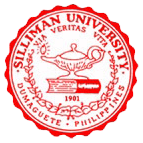 Seal of Silliman University |
|
| Motto | Via, Veritas, Vita |
| Motto in English | "The Way, The Truth, The Life" (John 14:6) |
| Established | 28 August 1901 |
| Type | Private |
| President | Dr. Ben S. Malayang III B.A., M.A., Ph.D. (Ohio University and University of California, Berkeley)[1] |
| Students | 8,792[2] |
| Location | |
| Campus | Urban 330,000 m² (Hibbard Avenue main campus) 290,000 m² (College of Agriculture and Marine Lab campus) |
| Former names | Silliman Institute (1901-1938) |
| Hymn | Silliman Song |
| Colors | Red white |
| Athletics | PRISAA, UNIGAMES[3] |
| Nickname | "Dear old Silliman"[4] "Silliman beside the sea"[5] |
| Mascot | Stallions and Mares |
| Affiliations | ACUCA, UBCHEA, ACSCU, ASAIHL, PAASCU, ATESEA, UCCP among others |
| Website | www.su.edu.ph |
 |
|
Silliman University (also referred to as Silliman or SU) is a Christian private university located in Dumaguete City, Negros Oriental, Philippines. Established in 1901 by Presbyterian missionaries, it was the first American private school to be founded in the country.[6] The University is named after Dr. Horace Brinsmade Silliman, a retired businessman and philanthropist from Cohoes, New York who gave the initial sum of $10,000 to start the school. For the first half of the 20th century, Silliman was run and operated by Americans. After the Second World War Filipinos began to assume more important positions culminating in the appointment of Silliman's first Filipino president in 1952.[7]
Today, the University comprises ten colleges, four schools, and two institutes, enrolling approximately over 8,700 students from different parts of the Philippines and over 26 foreign countries.[2][8] It is registered as a National Landmark by the National Historical Institute, and is one of few private higher education institutions in the Philippines that have been granted autonomy by the Commission on Higher Education.[6][9][10] In a report released by the Professional Regulation Commission and the Commission on Higher Education which covered a ten-year period, Silliman was ranked 4th in the country following three schools of the University of the Philippines.[11] It is also ranked among the top 150 universities in Asia based on International Students' Review by the QS Quacquarelli Symonds, an institution that ranks the world's top universities.[12]
Fifteen of its academic programs are on Level III accreditation status.[13] Academic programs of the University undergo regular accreditation under any of two accrediting agencies, namely: (1) the Association of Christian Schools, Colleges and Universities Accrediting Agency (ACSCU-AAI) or (2) the Philippine Accrediting Association of Schools, Colleges and Universities (PAASCU) which is a member Federation of Accrediting Agencies of the Philippines (FAAP). These accrediting agencies are all recognized by the Philippine educational system. The programs of Theology on the other hand are accredited with the Association for Theological Education in Southeast Asia (ATESEA), an international organization.[14][15]
The University is a founding member of the Association of Christian Universities and Colleges in Asia (ACUCA), and one of the recognized institutions in the U.S. Veterans Administration's list of approved educational institutions.[16][17][18]
Silliman offers programs in the early childhood, elementary, secondary, undergraduate and graduate levels. Programs in the undergraduate and graduate levels cover various disciplines such as Accountancy, Business Administration, Engineering, Information Technology, Law, Medicine, Nursing, Biology, Chemistry, Education, Marine Sciences, Physics, Theology, Philosophy, Psychology, and Public Administration. In addition to its academic undertakings, the University is also involved in research and community extension projects.[19][20]
Contents |
History
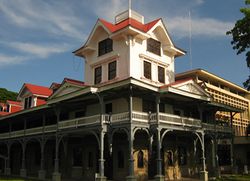
Silliman University was founded in August 28, 1901 as Silliman Institute by Protestant missionaries under the Board of Foreign Missions of the Presbyterian Church in the United States. Originally established as an industrial school for boys, operations for the Institute started through an initial $10,000 donation given by a businessman and Christian philanthropist of Cohoes, New York named Dr. Horace Brinsmade Silliman, who wanted to establish an industrial school using the Hampton Institute of Virginia model.[14][24]
The person tasked to found the institution was Dr. David Sutherland Hibbard, a man from Lyndon, Kansas who, after serving as a pastor in a Presbyterian church in that locality, offered his services to the Presbyterian Board as missionary. Upon his arrival in the Philippines, he was commissioned, together with his wife Laura, to scout the southern part of the Islands to determine the best location for the school. His original points of destination were Cebu, Zamboanga and Iloilo. While in Cebu, a suggestion came to him to make a side-trip to Dumaguete.[25] On his arrival, he was met by a Rev. Captain John Anthony Randolph, chaplain of the 6th U.S. Infantry Regiment stationed at that time in Dumaguete, who later on introduced him to Don Meliton Larena, the town's local presidente and to his brother Demetrio Larena, then the vice-governor of the province. Hibbard got attracted to the place and decided to establish the school in the locality. He would later on write that the "beauty of Dumaguete and the friendliness of the people" helped in bringing about his decision.[26]
The Institute had a modest beginning: Dr. and Mrs. Hibbard held classes in a rented house beside the sea until the Institute's first building, Silliman Hall, was completed in 1903.[18] Recalling how the University started half a century later, Dr. Hibbard described:[27]
| “ | There were fifteen boys that first morning. The equipment consisted of four desks about ten feet long, two tables and two chairs, a few McGuffey’s Readers, a few geographies, arithmetics and ninth-grade grammars. I was President; Mrs. Hibbard was the faculty. | ” |
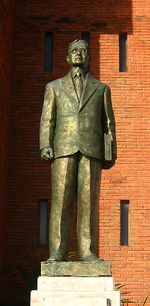
Enrollment in the school gradually grew thereafter to include students from other Asian countries.[14] In 1910, Silliman was awarded government recognition and the right to grant a degree. In the same year, it was incorporated under the laws of the Philippines. Women started to be admitted in 1912, and in 1921, the Silliman Bible School (later to become the Divinity School) was established in cooperation with the American Board of Commissioners for Foreign Missions, representing the Congregational Churches of the United States. As enrollment into the institution grew further, a corresponding increase in faculty followed. These developments were coupled with the use of a more developed curriculum and the construction and acquisition of more permanent buildings and equipment. By 1925, Silliman was already known as one of the foremost institutions for higher education in the Philippines, based on a report submitted by the Board of Educational Survey, which was created by the Philippine Legislature to conduct a study on all educational institutions in the country.[28][29] The Institute was re-incorporated in 1935, and in 1938 became the first school outside of Manila to be granted university status.[14][24]
After its recognition as a university, Silliman continued to receive from the Presbyterian Board and the American Board (now the United Church Board for World Ministries) grants for land, buildings and equipment. In addition, these Boards provided the University with American faculty and staff personnel. Two other American boards have contributed personnel and funds: the Board of Missions of the United Methodist Church and the United Christian Missionary Society of the Christian Churches (Disciples of Christ).[30]
Life in the University was interrupted when World War II came. On May 1942, some three weeks after the fall of Corregidor, two Japanese transports anchored in Dumaguete. Silliman was occupied by the Japanese forces and was converted into a garrison. One of its buildings, Channon Hall, became the headquarters of the dreaded Japanese kempeitai or military police where many Filipinos were tortured and killed. During the occupation, many members of the faculty and the student body were forced to evacuate to four localities within the province. Under the leadership of Dr. Arthur Carson, then president of Silliman, the remaining members of the faculty continued the operations of the University in the mountains of Negros Oriental. This led to the formation of what was then called the "Jungle University" in Malabo, Valencia -one of the localities in the province.[14][31]
American and Filipino forces liberated Dumaguete on April 26, 1945. A few days later, the Faculty Emergency Committee took charge over the campus, and began preparations for the resumption of classes and the big challenge of reconstruction.
For the first half of the century, Silliman was run and operated by Americans. After the Second World War and until the early nineteen fifties, moves for the Filipinization of the university administration began to come closer to the surface. Filipino members of the faculty began to assume more important positions, and as more of these faculty members took administrative roles, the Board of Trustees elected the University's first Filipino president, Dr. Leopoldo Ruiz, in August 26, 1952, officially taking office on April 1953. A Silliman alumnus (A.B.'16), Ruiz had a long experience in higher education and in the foreign service. Prior to his appointment, he took up graduate studies in sociology at Columbia and Yale, with an M.A. (1924) from the former institution, as well as a Ph.D. (1942) from the University of Southern California.[31]
In the same decade of Ruiz's appointment, the United Board for Christian Higher Education in Asia (UBCHEA) in New York, an interdenominational group, assumed responsibility for channeling all church aid to Silliman. The United Board is an international organization supported by ten Protestant mission boards.[18] Even long after Ruiz's appointment, however, Americans and other nationals still constituted a considerable portion in the University's faculty,[31] and up to the present, American and foreign visiting professors are still regularly assigned in specialized areas.[32][33][34]
In the early 1960s and towards the beginning of the Martial Law years, the University embarked on a "Build a Greater Silliman" program in response to the growing student population and the corresponding need for more facilities. With much help from many donors, mostly alumni and entities from abroad, the program saw the construction of more academic buildings, dormitories, housing units for the faculty and other facilities. These constructions included the now famous Luce Auditorium which was funded largely by the Henry Luce Foundation, the Science Complex, equipped with an observatory on top of the third floor, the Engineering Complex, and the Silliman University Medical Center.[31]
When Martial Law was declared in 1972, Silliman became one of the first two universities ordered by the government to be closed, and one of the last to be opened. On the morning of September 23, 1972 some faculty members and many students were rounded up by the local Philippine Constabulary (now the Philippine National Police), some of whom were detained for periods ranging from one to six months. Many offices of the University, including the Weekly Sillimanian, the University's student paper, were raided by the PC.[31]
The year 1979 became a landmark year for Silliman when its Van Houweling Research Laboratory, then headed by Dr. George Beran,[35] produced a dog vaccine that gave a three-year immunity from rabies, making it the first and only laboratory to produce a rabies vaccine with long-term immunity in the whole of Southeast Asia.[36] The development of the vaccine resulted in the elimination of rabies in many parts of the Visayas and Mindanao Islands and was later on used by other countries in their fight against rabies conducted in collaboration with the World Health Organization.[37]
The 1980s saw the restoration of the University’s Student Government and the approval of its constitution. After years of suppression by the Marcos regime, students were again allowed to self-organize in 1981. The decade also witnessed the 100% board exam ratings of the Electrical Engineering, Nursing and Accountancy programs and the installation of solar-powered light posts in the campus in the years 1986 and 1989 respectively.[36]
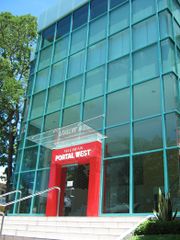
The 1990s saw the University shifting its grading system from alphabetical to numerical. In 1994, eleven Sillimanians landed in the top ten of that year’s nursing board exam, with twenty two other Sillimanian takers occupying the top twenty posts in said exam. In that same year, Silliman alumnus Gonzalo O. Catan Jr., was awarded Most Outstanding Inventor in the 5th National Technology Fair. The decade also witnessed Silliman being cited as the University with the best published scientific paper in the Dr. Elvira O. Tan Awards; and in 1995, the University hosted the first ever International Conference on Biology and Conservation of Small Cetaceans of Southeast Asia, as well as the International Coral Reef Initiative Workshop.[36]
Towards the end of the decade, Silliman prepared for its centennial celebrations. To strengthen its local area network technology, the University installed fiber-optic cables that span the entire 62 hectare campus in 1999. In 2000, the Silliman Accountancy program ranked 1st in the country, culminating in its Physical Therapy program ranking 1st in 2001.[36]
At present, Silliman University continues to draw support from the United Board for Christian Higher Education in Asia (UBCHEA), as well as from its alumni and other benefactors. Envisioned by its founders as a mission institution, the University has adopted a policy of providing quality education to the surrounding regions without depending much on tuition and other fees to meet its operational expenses. Recently, Silliman constructed the Portal West Building, a five storey commercial building on campus, to help augment the University's operational expenses. In line with the same policy, it has leased portions of its properties to certain business entities to further raise its financial base.
Due to the fact that a significant portion of the student population ride on motorbikes and scooters, the University has also aggressively adopted a "No Helmet-No Entry" policy. Silliman has likewise adopted a "No-Smoking Policy" on campus.[38]
Silliman is one of few private higher educational institutions in the country that have been granted full autonomous status by the Commission on Higher Education (CHED), the same government agency that recognized some of its programs as Centers of Excellence and Centers of Development.[39] To date, fifteen of the University's academic programs have been given Level III accreditation by recognized accrediting agencies.[13]
Campus
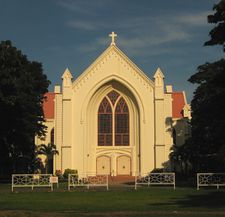
Silliman is located in Dumaguete City, a quiet, peaceful seaside community with a population of 116,392.[41][42] The University has two campuses: the Hibbard Avenue main campus, and the College of Agriculture and Marine Lab campus. Dotted by large acacia trees, the main campus has a land area of 33 hectares. It is home to most of the colleges and schools of the University and is adjacent to the city's downtown district. It faces the sea to the east, flanked by its portals which are now considered as symbols both of the University and of the city. The three most prominent portals are the Gates of Knowledge, Opportunity and Service. The Gate of Knowledge is the current and main entrance to the University and is the starting point of the two-kilometer long Hibbard Avenue which was named after Dr. David Sutherland Hibbard, one of the founders of the institution. The other prominent landmarks on the main campus are the Silliman Hall, which now houses the Anthropology Museum; the Silliman University Church; the University Library; and the Luce Auditorium, the largest theater outside Metro Manila.[43] Regularly frequented by tourists, the University maintains a campus cruiser, a 15-seater golf cart or tram-like vehicle used to ferry visitors around the campus. It is also utilized to service students during regular days.[44]
Two kilometers to the north (the other end of Hibbard Avenue) is the College of Agriculture and Marine Lab campus. It has a land area of 29 hectares, and houses the College of Agriculture Complex, the Silliman Farm, a number of dormitories (known as the Cocofed Dormitories) and the Marine Laboratory. Adjacent to the Marine Laboratory is the Silliman Beach.
Silliman also has off-campus facilities located in Camp Lookout, Valencia and on Ticao Island, in the Province of Masbate. The Camp Lookout facility houses the University's Creative Writing Center which now serves as the venue and permanent home of the Silliman National Writers Workshop. The Center has a two-storey main function hall and five duplex cottages.[48]
The University's Ticao Island facility on the other hand is a 465 hectare property located in the Province of Masbate, another island in the Visayas. Donated by the family of Mrs. Elizabeth How, the facility is a combination of a working ranch, agricultural plantations, and patches of secondary forests. A framework for a long-term development plan has been made and is now the subject for validation by local stakeholders in the area. The plan includes programs for agriculture, Christian ministry, coastal resource management and public health.[15][49]
Dumaguete has been called a "center of learning in the south", or a "university town" due to the presence of Silliman and other local universities that have made their mark nationally and abroad.[50][51] The city has become a melting pot of students, professionals, artists, scholars and the literati coming from different parts of the country and the world.[52][53]
Museums
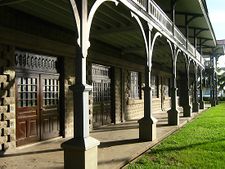
Silliman has three museums: the Anthropology Museum, the Gonzales Museum of Natural History, and the Marine Mammal Museum of the Institute of Environmental and Marine Sciences (IEMS). The Anthropology Museum is located at the old Silliman Hall on the southeastern side of the main campus. Established in 1973, it was opened to bring the importance of the Filipino’s cultural heritage to the attention of the public. The bulk of the artifacts displayed came from fieldworks, excavations, purchases and donations. The museum has seven galleries. The first three, contain exhibits which have been collected from known cultural or ethnic groups all over the country. These items or artifacts include simple tools and instruments such as basketry, agricultural and aquatic tools, weapons, clothing and ornaments as well as musical instruments. The display is based on two general criteria namely –the type of social organization (incipient, tribal or sultanate) and the type of economic subsistence (hunting, and gathering, marginal agriculture or farming) under which ethnic group is categorized. The exhibit on the last four galleries are artifacts excavated from different parts of Negros Island and in the mountain areas of Cotabato. A number of excavations done by Sillimanian anthropologists way back in the 1970s yielded ancient artifacts, like burial urns, and porcelain pieces which date back to the Sung period in the twelfth century.[31][54]
The other two museums are the Gonzales Museum of Natural History and the Marine Mammal Museum. The Gonzales Biology Museum is located at the first floor of the Science Complex. It showcases a collection of preserved animals traditionally found in the tropics such as different kinds of fishes, crustaceans, snakes, eagles, birds, flying lemurs, etc. The museum was named in honor Prof. Rodolfo Gonzales, a former biology teacher of the University.[55] The Marine Mammal Museum on the other hand contains a large collection of whale and dolphin bones. It is located at a facility of the Institute of Environmental and Marine Sciences two kilometers north of the main campus.
Administration
Silliman is governed by an independent Board of Trustees composed of fifteen members. Five of its members come from the Silliman University Foundation Incorporated (SUFI); five from the UCCP; and another five from the alumni. The President of the University sits as an ex-officio member. Under the Board are the different administrators composed of the University President, the Vice-President for Academic Affairs, Vice-President for Finance, the University Registrar, Treasurer and Auditor as well as the Manager for Human Resource (HRD).[56] Assisting the VPs for Academic Affairs and Finance are the different Deans, Directors, Department Chairpersons, Coordinators and Unit Heads of the different colleges, schools, institutes, units, research centers, programs and extension projects of the University.[57] Though the University is affiliated with the United Church of Christ in the Philippines, it is officially nonsectarian for not having adopted any "articles of faith." Its academic environment has remained generally liberal and its Christian orientation has in no way discouraged the expression or exercise of other beliefs.[41][58] Majority of the University's student and faculty population are Roman Catholics, with a significant portion of Muslims from Mindanao and the Middle East.[14][59]
Academics
| Presidents of Silliman University |
| David S. Hibbard, M.A. (Princeton), 1901-1930 |
| Roy H. Brown, D.D. (Park U), 1932-1936 |
| Arthur L. Carson, Ph.D. (Cornell), 1939-1953 |
| Leopoldo T. Ruiz, Ph.D. (Columbia/Yale),1953-1961 |
| Cicero D. Calderon, J.S.D. (Yale), 1962-1971 |
| Quintin S. Doromal, M.A. (Harvard), 1973-1982 |
| Venancio D. Aldecoa, Jr., Ll.B. (Silliman), 1983-1986 |
| Pedro V. Flores, Ed.D. (Penn State), 1987-1989 |
| Angel C. Alcala, Ph.D. (Stanford), 1991-1992 |
| Mervyn J. Misajon, Ph.D. (Michigan), 1994-1996 |
| Agustin A. Pulido, Ph.D. (Indiana), 1996-2006 |
| Ben S. Malayang III, Ph.D. (Ohio/UC Berkeley), 2006-Present[a] |
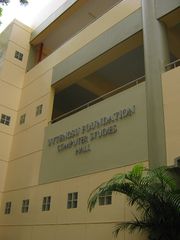
Rankings
In a 2007 report released by the Professional Regulation Commission (PRC) and the Commission on Higher Education (CHED), Silliman University was ranked 4th in the country, following three schools of the University of the Philippines (UP) namely, UP-Diliman, UP-Los Baños, and UP-Manila, which ranked 1st, 2nd and 3rd respectively. The survey was based on average passing rates in Board examinations from 1991 - 2001 in all courses of all universities and colleges in the Philippines. The study is conducted every ten years.[11]
In other board or licensure examination-related reports released by the CHED in the year 2009, Silliman was ranked 1st in the country in the field of Nursing Education[60] and 2nd in the fields of Accountancy[61] and Mechanical Engineering.[62][63]
Internationally, Silliman is ranked among the top 150 universities in Asia based on International Students' Review by the QS Quacquarelli Symonds, an institution that ranks the world's top universities.[64]
Recognition
The Commission on Higher Education (CHED) designated Silliman as a Center of Excellence in Nursing Education and Teacher Education, and a Center of Development in Biology, Marine Sciences, Information Technology and Accountancy Education.[14][15] Aside from these, the University was also named by the United States Agency for International Development as a Center of Excellence in Coastal Resource Management, and by the Haribon Foundation as an Academic Center of Excellence in Biodiversity Conservation.[65][66][67][68] Due to the University's community-based coastal resource management program, Apo Island, a small island off the coast of Dauin, was recognized as one of the best diving spots in the world.[14][69][70]
International Linkages
On top of its strong affiliation with the United Board for Christian Higher Education in Asia (UBCHEA) and other international development organizations, Silliman maintains various linkages on collaborative research as well as on faculty and student exchange, with universities in the United States and Asia. Its longest running student exchange programs are with three Japanese universities: International Christian University, Ferris University and Shikoku Gakuin University.[14][71][72] Silliman also maintains research and academic linkages with the University of Washington (USA), California State University, East Bay (USA), Gordon College (USA), the Smithsonian Institution (USA), Texas Tech University (USA), Ritsumeikan Asia Pacific University (Japan), Sookmyung Women’s University (South Korea), Hanyang University (South Korea), Sam Ratulangi University (Indonesia) and the Asian College of Nursing and Health (Malaysia).[17][73][74][75][76][77][78][79][80][81]
Academic Units
Silliman University confers bachelor's, master's, and doctoral degrees accredited by either ACSCU-AAI, PAASCU (a member of FAAP), or ATESEA in its present colleges, schools and institutes:
Colleges

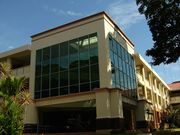
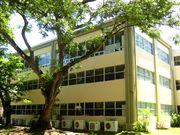
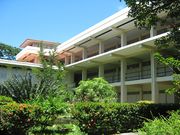
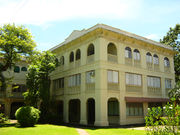
- The College of Agriculture offers undergraduate programs in Agribusiness, Agronomy and Animal Science. Located in a 24 hectare agricultural complex, two kilometers north of the main campus, the College’s beginnings can be traced as early as 1913, when Dr. Sutherland Hibbard, first president of Silliman Institute, was instructed by the founders to make provisions for a “school garden and a farm”. In 1950, it was formally established as a Department, and in 1976, was elevated into what was then known as the School of Agriculture. The years 1977 to 1980 saw the construction of modern classrooms, a laboratory complex, eight dormitories and a library, transforming it into what is now known as the “College of Agriculture”.[15][83]
- The College of Arts and Sciences has 18 major courses leading to several degree programs. At present, it is composed of the departments of Anthropology and Sociology, Biology, Chemistry, English and Literature, History and Political Science, Filipino and Foreign Languages, Mathematics, Philosophy and Religion, Physics, Psychology, Social Work, and the Speech Department. During the early years of its founding (1902 up to the war years), the College of Arts and Sciences was composed of the College of Liberal Arts and the College of Sciences. Starting in 1947, however, both colleges merged to become the College of Arts and Sciences.[15][83]
- The College of Business Administration offers five undergraduate courses in Business Administration (majors in General Business, Management and Economics), Accountancy, Entrepreneurship, Business Computer Applications, and Office Management. It also has one graduate program in Business Administration namely Master in Business Administration. Established as a college in 1938, it is currently composed of the departments of Management, Economics, Accountancy, Business Computer Applications, Entrepreneurship, and Commercial Science. Due to its consistently high performance in accountancy board examinations, the College has been designated by CHED as a Center of Development in Accountancy Education.[15][83] In the October 2009 CPA Licensure Examinations (10-25 examinees category), Silliman ranked 2nd in the country.[61]
- The College of Computer Studies offers undergraduate courses in Computer Science, Information Technology, and Information Systems. Due to its established IT infrastructure and well-developed curriculum, the College was designated by CHED as a Center of Development in Information Technology Education. Silliman is one of only two universities in the Philippines that has an extensive fiber-optic backbone and the only school in the country that owns its fiber-optic system. Costing US $2.5 million in 1997, this backbone connects all buildings in the campus. Silliman was also the first school in the country to use wireless Wi-Fi B2B LAN technology.[84] Recently, the College opened its masters degree in Information Systems,[85][86] and pilot tested the Silliman Online University Learning (SOUL) website, a virtual classroom for students.[15][83] It has also formed partnerships with Microsoft and IBM. The Microsoft Developer Network Academic Alliance has given the College a 3-year complimentary MSDNAA subscription which allows it to download available software in MSDNAA for free to all students and faculty for teaching and learning purposes, while the College's partnership with IBM resulted in the introduction of the IBM Academic Exchange Offering. Electives under the program are developed for junior and graduating students majoring in Information Technology, Information Systems and Computer Science.[85][87]
- The College of Engineering and Design started as a Department of Engineering in June 1932, offering an undergraduate program in Civil Engineering. In March 1935, the Board of Trustees authorized the change in status of Silliman from an Institute to a University. With government approval of this change, Silliman proceeded to adopt additional undergraduate programs in Mining Engineering, Chemical Engineering and Industrial Engineering. Today, the College offers four undergraduate courses in: Civil Engineering; Computer Engineering; Electrical Engineering; and Mechanical Engineering.[15][83] In the October 2009 Mechanical Engineering Licensure Examinations (Category A), Silliman was ranked 2nd in the country.[62][63][88]
- The College of Education has been designated by CHED as Center of Excellence in Teacher Education. The College has three departments: Physical Education, Teacher Education, and Nutrition and Dietetics. Its beginnings can be traced way back in 1924 when it first offered diplomas in Bachelor of Science in Education. From then on, the Teacher Education Program grew and developed into what is now known as the College of Education.[15][83]
- The College of Law was established in 1935, starting with a freshman class of 22 members. Guided by its motto "Law with a Conscience", the College seeks to teach its students not just the correct understanding of legal provisions and principles but their ethical implementation to society and people.[15][83] It is also home to the Dr. Jovito R. Salonga Center for Law and Development.[89] Starting SY 2009-2010, the College shifted its course offering from Bachelor of Laws (LLB) to Juris Doctor (JD).[90] Silliman is the first law school to offer the JD program in the Visayas and Mindanao area.[91]
- The College of Mass Communication was established in 1966 as the first school outside of metropolitan Manila to offer a degree program in Journalism.[92] Its founding director was D. Wayne Rowland, Ph.D., a visiting professor in journalism from Texas Christian University. In 1976, the College (then known as the School of Communication) changed its course offering from a bachelor's degree in Journalism to that of Mass Communication to cover the ever expanding field of mass communication.[93]
- The College of Nursing has been designated by CHED as a Center of Excellence in Nursing Education. The College offers one undergraduate course in Nursing and three graduate courses namely: (1) Master in Nursing [non-thesis] Majors in Family Nursing Practice, Administration, Public Health Nursing, Adult Health and Psychiatric-Mental Health Nursing; (2) Master of Science in Nursing Majors in Parent-Child Nursing, Nursing School Administration, Nursing Service Administration, Public Health Nursing, Medical Surgical Nursing, Psychiatric-Mental Nursing, Family Nursing Practice, Community Health Nursing and Adult Health; and (3) Ph.D. in Nursing. Founded in 1947, the College is known for its ratings in the professional licensure exams which have been consistently higher than the national average.[15][83] In a 2009 report handed down by CHED, Silliman was ranked 1st in the country.[60][94]
- The College of Performing Arts is home to three areas of specialization: Fine Arts, Music, and Theater Arts.The College started in 1912 as a music department in the College of Arts and Sciences. With the arrival of American missionary Geraldine Kate in 1934, it was transformed into a Conservatory of Music, with Kate as its founding director. In 1941, it became a School of Music, and with the addition of the Fine Arts Department in 1969, it was renamed as the School of Music and Fine Arts. Due to developments within the school it was given college status in 2001 and renamed as the College of Performing Arts.[15][83]
Schools
- The Divinity School offers undergraduate and graduate programs in Divinity, Ministry and Theology. Starting in 1921 as the Silliman Bible School, this academic unit used to be a Congregationalist-Presbyterian training school for Visayan-speaking candidates in pastoral ministry. Today, the Divinity School has in its roster, students from Luzon, Visayas, Mindanao, and the Southeast Asian region.[15][83]
- The Medical School is a new addition to the University. Established in 2004, it has a faculty of 50 medical doctors specializing in Anesthesiology, Cardiology, Endocrinology, Eye-Ear-Nose-Throat, Family Medicine Gastroenterology, General Surgery, Hematology, Infectious Diseases, Internal Medicine, Nephrology, Neurology, Neuro-Surgery, Nuclear Medicine, Obstetrics and Gynecology, Oncology, Orthopedic Surgery, Pediatrics, Psychiatry, Public Health Administration, Pulmonary Medicine, Rehabilitation Medicine, and Urology.[15][83]
- The School of Public Affairs and Governance started in June 2007 to provide formal training in the management of local government affairs. It specializes in three areas: Fiscal Administration, Local Governance, and Criminal Justice System. The School aims to beef up the expertise of public servants to become more efficient administrators who can discharge their duties in the most economical way with maximum results. A distinguished panel of guest lecturers from Manila and abroad join the resident faculty of Silliman in teaching the courses.[15][83]
- The School of Basic Education is home to three departments: Early Childhood, Elementary, and High School. When Silliman Institute (former name of Silliman University) was founded in 1901, it started as an elementary school; thus, making the Elementary Department the oldest unit in the University. In 1916, the first high school diplomas were awarded, and in 1957-58, funding for an Early Childhood School building was secured. Historically, the Early Childhood, Elementary and High School departments operated separately. Due to developments within the University in 2001, however, and to facilitate better coordination between these departments, the early childhood, elementary, and high schools, were merged as one unit, forming what is now known as the School of Basic Education.[15][83]
Institutes
- The Institute of Clinical Laboratory Sciences offers one undergraduate course in Medical Technology. The Institute started as a program under the Biology Department of the College of Arts and Sciences in 1970. Due to its growing population, exemplary performance in licensure examinations and need for autonomy, it was separated and converted into a department under the same college in 1987, making it into a Department of Medical Technology. In 1995, the University reorganized some of its programs and transferred the Medical Technology department to the College of Nursing, creating a new college named College of Nursing and Allied Health Sciences. Starting SY 2009-2010 however, in a bid to give the Department more autonomy in crafting its own academic direction, it was separated from the College of Nursing as an entirely autonomous institute.[15][83]
- The Institute of Rehabilitative Sciences, offers one undergraduate course in Physical Therapy. Like the Medical Technology Department, the Institute also started as a program under the College of Arts and Sciences. It was subsequently transferred to the College of Nursing together with the Medical Technology Department, forming a new College, the College of Nursing and Allied Health Sciences. For over a decade, the Physical Therapy program was attached to the College of Nursing and Allied Health Sciences. However, to give it more autonomy the program was separated from the College in SY 2009-2010 and reorganized as the Institute of Rehabilitative Sciences.[15][83]
Library System
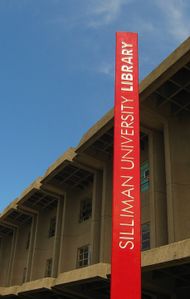
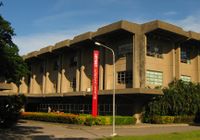
The Silliman Library System is composed of the Robert B. and Metta J. Silliman Library, which serves as the university library, and the local libraries of the College of Agriculture, College of Business Administration, College of Law, the Divinity School, High School, Elementary and Early Childhood Schools. Among these libraries the Robert B. and Metta J. Silliman Library (university library) serves as the largest repository of books, periodicals and other reading materials. Built in 1978, the university library is a three-storey structure with a seating capacity of 490 readers. It holds over 250,000 volumes,[14] with enough space to accommodate 400,000 more. It also subscribes to 500 periodicals. Some courses provide instruction in the location of books and publications for research and other school work. Students can search for library materials using the On-Line Public Access Catalogue. Instructions on how to use it are posted on the stations were the system is installed. Research can also be done using the Internet through the Cyberlibrary. Students pay a semestral fee to avail of this service.[95][96]
Aside from the main section of the library which contains the bulk of its book and periodical collection, other notable sections of the facility include the Filipiniana section, containing books and materials published by famous Filipino authors during the Spanish and pre-war periods of the country, and the Sillimaniana section, containing Silliman memorabilia from 1901 up to the present (e.g. trophies, plaques of recognition, portraits of past presidents, etc.), and an archive of past publications and documents.
The university library is likewise home to two notable centers: The American Studies Resource Center (ASRC) and the World Bank Knowledge for Development Center (WB-KDC). The American Studies Resource Center (ASRC) is a result of a memorandum of agreement between the United States Embassy in Manila and Silliman University. It is the only ASRC in Region VII hosted by an academic institution. The ASRC provides a variety of materials: books, periodicals, CD-ROMS, DVDs, VCDs, VHS tapes, electronic materials for those interested in studies and issues related to the United States.[97]
The World Bank Knowledge for Development Center on the other hand is a result of a partnership between the University and the World Bank. It contains an extensive collection of development publications and World Bank project documents to people involved in the academe, researchers, NGOs, media, government agencies and the business sector. The section is open to the public.[98]
To date, the Silliman Library remains to be one of the biggest libraries in the Philippines.[99][100] In 2008, the Silliman University Library System was given the "Outstanding Library Award" by the Philippine Association of Academic and Research Librarians (PAARL) for its growing collection and ongoing computerization program.[14][101][102]
Medical Center
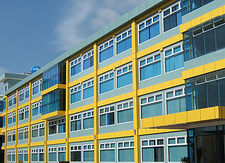
Although institutionally distinct from the University, the Silliman Medical Center (SUMCFI) supports the academic institution by serving as its base facility for the internship programs of the College of Nursing, School of Medicine, the Institutes of Clinical Laboratory and Rehabilitative Sciences, the Divinity School (for its chaplaincy program), and the Nutrition and Dietetics Department.
Silliman Medical Center, is a 140-bed hospital located on campus, with comprehensive medical services available both to students and to the community in general. It currently has collaborative ties with St. Luke's Medical Center.[103] The Silliman Medical Center started as an infirmary in 1901 until it became a hospital in 1923.[104] In 1974, the cornerstone for a New Medical Center was laid down by the Netherlands Ambassador to the Philippines to commence the building of a four-storey structure with passenger elevators (the first in Negros Oriental).[31] Inaugurated in 1976, it is considered as one of the most modern hospitals outside Metro Manila and Cebu.[105] In 1979, the Medical Center made history when its Van Houweling Laboratory discovered and produced a dog vaccine that gave a three-year immunity from rabies. The development of the vaccine was later used by other countries, in collaboration with the World Health Organization, on their fight against rabies.[106] Recently, a new Medical Arts Building was added [107] to the main structure of the hospital to further address the growing needs of the surrounding community.
Research and Extension
Concurrent with its academic undertakings, the University is also engaged in collaborative research and community extension programs. It has established a number of research centers foremost of which is the Silliman University Marine Laboratory (SUML) now the Institute of Environmental and Marine Sciences (IEMS). The Institute is a research facility in the field of marine sciences located at Silliman Beach, two kilometers north of the main campus. It was established in 1974 through a modest grant from the United Church of Canada. Since then, it has produced notable research in conservation and management which are being applied in cooperative projects in different local communities, such as the conservation programs in Sumilon and Apo Islands.[18][69] Since its founding, the Institute's research and conservation activities has led to the establishment of 20 marine protected areas (MPAs) and provided assistance to 61 others in the Visayas and Mindanao. For its research and biodiversity conservation efforts, Silliman University was recognized by the Commission on Higher Education as the best in research program in the country.[19]
As a research extension and teaching facility, the Institute works with other departments of the University, namely, the Biology, Chemistry, Physics, and Social Work departments, the College of Law, and the Silliman University Extension Program.[18] Currently, the Institute is involved in numerous projects such as the Giant Clam Project, Grouper Culture, Crocodylus mindorensis (Philippine crocodile) Breeding Project, and the Bais Bay and Apo Island Continuing Support Program.[108]
Other research centers and extension programs of the University include:[15][109]
|
|
Culture and Traditions
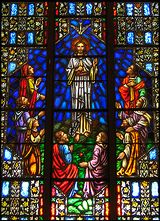
Via, Veritas, Vita
Is a Latin phrase which means “The Way, The Truth, and The Life.” Chosen by the University as its motto, this phrase is attributed to Jesus Christ and is found in the Gospel of John chapter 14, verse 6, which reads: “5Thomas said to him, "Lord, we don't know where you are going, so how can we know the way?" 6Jesus answered, "I am the way and the truth and the life. No one comes to the Father except through me. 7If you really knew me, you would know my Father as well. From now on, you do know him and have seen him." (New International Version) The choice of the motto is firmly rooted in the University’s belief that religious instruction, particularly in the teachings of Jesus Christ, is essential to the moral development of every young person.[31] Incidentally, the motto has also been adopted by the Province of Negros Oriental by incorporating it in its provincial seal.
Galilean Fellowships
Once every semester, the Silliman academic community celebrates the University Christian Life Emphasis Week (UCLEW). In this week-long celebration, the University encourages all students to participate in the different Bible study or fellowship activities held in the homes and cottages of assigned members of the Silliman academic or religious community. Conducted after classes, these sessions are called the Galilean Fellowships. Galilean fellowships are brief devotional sessions where participants are given the opportunity to reflect on the teachings of the Bible, relax, share their thoughts and experiences, and have fellowship with other members of the academic community.[110]
Founders Day
Founders Day is part of a week-long event (sometimes referred to as the Founders Week), conducted by the Silliman community to commemorate the founding of the University. This event is held on the last week of August. The celebration is characterized by class reunions, alumni, fraternity and organizational gatherings, concerts, exhibits, booth-building, awarding ceremonies (e.g. the Outstanding Sillimanian Awards), and invitational games with other schools.[107][111] The week-long celebration is traditionally commenced by an early morning worship service called, "Sunrise Service", at the Silliman University Church, and culminated with a city-wide parade held on the anniversary of the University's founding, August 28. The parade is referred to as the "Parada Sillimaniana" and August 28 is referred to as the "Founders Day" in honor of the pioneers. For the past few years,however, the University moved the parades to August 27. Traditionally, the parade is characterized by the use of floats, with each float representing a particular college, department, or school.
Silliman Song
Before the end of an important event or ceremony the Silliman Song is sung by the attendees. The lyrics of the song was written in 1918 by Dr. Paul Doltz, then the Vice-President of Silliman Institute and pastor of Silliman Church. The tune of the song is an adaptation or modification of "Old Nassau" of Princeton University, Dr. Doltz's alma mater.[31] It briefly describes Silliman's tranquil location; the student's college or university experience; the student's victories, whether it be in the classroom, the court, the track, or the field; the highs and lows in life; and the principles that the graduate brings as the latter leaves the halls of the University.[112] Sang by the Silliman community for almost a hundred years, the Silliman Song has popularized the phrases "Dear old Silliman", and "Silliman beside the sea".[4][5]
Student life
Athletics
Silliman has several athletic facilities. The University Gymnasium is a multipurpose facility used for basketball, volleyball, badminton, rock-climbing, table-tennis, cheering, and other indoor activities. The Silliman Ballfield is primarily used for soccer, and for track and field events. Other athletic facilities include a swimming pool, three tennis courts, two pelota courts, and an archery range.[96]
Silliman also has varsity teams for almost every major sport. A regular participant of the Philippine University Games (UniGames) and the Private Schools Athletic Association (PRISAA), Silliman is represented by a red and white Stallion or Mare.[113][114] In the recent Beijing Olympics, Mark Javier,a Sillimanian, represented the Philippines in the field of Archery. He was the lone male archer that represented the country.[115] Other notable Philippine Olympians that came from Silliman include Jennifer Chan, who recently won a gold medal in the 25th SEA Games, Lisa Ygnalaga, and long jumper Simeon Toribio.[116][14][117]
Student government
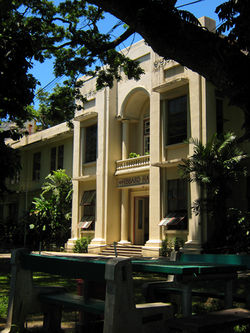
The coordination of student activities and student organizations are handled by the Silliman University Student Government (SUSG). Under the present set-up the Student Government is divided into three branches: the executive, the legislative, and the judicial departments. The executive power is exercised by the President with the assistance of the Cabinet. The Cabinet is composed of the President, Vice President and the respective heads of the Executive Committee who are appointed by the President. The legislative power of the SUSG is vested in the Student Assembly. It is composed of elected representatives of the different schools and colleges. The Justice Committee exercises judicial power. It is composed of the Prime Justice and six other justices appointed by the President upon recommendation of the Committee on Appointments. Election of Student Government officers are held before the close of the academic year.[30] Political campaigns or rallies may be held after securing the necessary permits. Political campaigns in the University are characterized by rallies in the Amphitheater, classroom-to-classroom speaking engagements, and dorm-to-dorm campaigns. The Student Government is under the supervision and oversight of the Student Organizations and Activities Division (SOAD).[18]
Organizations

Numerous student organizations are registered in the University. Some are regional societies organized to promote fellowship among students from particular geographical areas. There are service clubs such as fraternities and sororities which carry out, as part of their activities, projects on campus and in the community. Others are identified with particular academic disciplines such as chemistry and mathematics known as course-related organizations, and still others belong to the special or interest groups. The supervision and coordination of student organizations are undertaken by the Student Organizations and Activities Division (SOAD) together with the Silliman University Student Government (SUSG).[18]
Student Publications
There are five student publications in the University namely, the Weekly Sillimanian, one of the first weekly student papers in the country, with its existence dating back as early as 1903; the Portal, official yearbook of the University, first published in 1913; the Sands and Coral, a literary journal published in cooperation with the Department of English; the Junior Sillimanian, a publication of students from the High School Department; and the Stones and Pebbles, a publication of students from the Elementary School.[118]
Except for the Junior Sillimanian and the Stones and Pebbles, key positions in these publications carry honoraria and are available to all students through competitive examinations. These publications are supported by the students through a publication fee.[18]
Dormitories and Faculty Housing
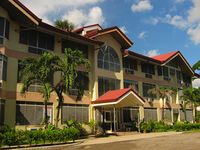
Silliman operates regular and cooperative dormitories which can provide space for approximately 800 students. These dormitories are either named after Philippine trees, flowers or significant historical figures of the University. There are six regular dormitories (four for women and two for men) and seven cooperative dormitories (four for women and three for men). The regular dormitories for women are Edith Carson, Ethel Chapman, Larena and the Woodward Hall. For men, the regular dormitories are the New Men's Dorm and Doltz Hall. Meals under these dormitories are supervised by the University Food Services. Housekeeping is generally maintained by a dorm staff.
The second type of dormitories are the cooperative dormitories. Under these dormitories, residents undertake the housekeeping and planning of the food. Named after flowers except one, the cooperative dormitories for women are the Azucena, Rosal, and Sampaguita Cottages, as well as Channon Hall. For men, the dormitories are named after trees. These are the Ipil, Molave, and Narra Cottages.
In addition to the aforementioned dormitories, the University maintains a number of cottages for some members of its faculty and staff as well as for guests and visiting alumni.[18]
Alumni
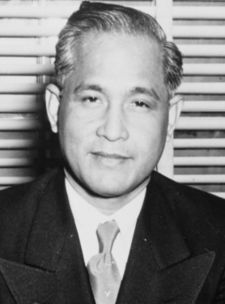
Presently, Silliman has forty duly organized and recognized alumni chapters throughout the world. Five (5) of these are based in the U.S and Canada.[119] Notable alumni of the university include Carlos P. Garcia, 8th President of the Philippines;[120] Senators Robert Barbers, Lorenzo Teves, and the Great Filibuster Roseller Lim;[121] House Speaker Cornelio Villareal;[122] John Gokongwei, Sr., a Philippine business magnate;[123] Frederick Dael, former CEO and President of Pepsi Cola Asia Pacific, and former CEO of Islacom; [124] Vicente Sinco, one of the signatories of the UN Charter in 1945, the 8th President of the University of the Philippines, and founder of Foundation University;[125] MacArthur Corsino, current Philippine Ambassador to the Republic of Cuba;[126][127] Antonio P. Villamor, current Philippine Ambassador to the Kingdom of Saudi Arabia;[128] Juanita Amatong, former Secretary of the Department of Finance and First Woman Executive Director in the World Bank Group from the Philippines;[129] Angel C. Alcala, Ramon Magsaysay Awardee for Public Service and former Secretary of the Department of Environment and Natural Resources; Leonor M. Briones, former National Treasurer of the Republic of the Philippines;[130][131] Emilio Macias II, former Governor of Negros Oriental;[132] Efren N. Padilla, Executive Director, Center for Filipino Studies California State University, East Bay;[133][134] Jose Andrada, first commanding officer of the Philippine Navy (formerly Off Shore Patrol) under the Philippine Commonwealth way back 1939 and after whom the Headquarters of the Philippine Navy is now named;[135][136][137] Edith L. Tiempo, National Artist for Literature (1999);[138] Edilberto K. Tiempo, Filipino writer, professor and founder of the Silliman National Writers Workshop; Eddie S. Romero, National Artist for Cinema and Broadcast Arts (2003);[139][140] Leoncio P. Deriada, Palanca Awards Hall of Famer;[141]César Ruiz Aquino, Filipino poet and fictionist;[142][143] and Simeon Toribio, one of few Filipinos who won medals in the history of World Olympics.[144]
Notes and references
Notes
- a. ^ Presidents of Silliman and their alma mater : David S. Hibbard, M.A. (Princeton University).[145] He later on acquired several honorary doctorates;[146] Roy H. Brown, D.D. (Park University);[147] Arthur L. Carson, Ph.D. (Cornell University);[148] Leopoldo T. Ruiz, M.A., Ph.D. (Columbia and Yale University);[31] Cicero D. Calderon, J.S.D. (Yale University);[149] Quintin S. Doromal, M.A. (Harvard University);[150][151] Venancio D. Aldecoa, LL.B. (Silliman University). He served as Judge and later on as Justice of the Court of Appeals;[152] Pedro V. Flores, Ed.D (Pennsylvania State University); Angel C. Alcala, Ph.D. (Stanford University);[153] Mervyn J. Misajon, Ph.D. (Michigan State University); Agustin A. Pulido, Ph.D. (Indiana University);[154] and Ben S. Malayang, M.A., Ph.D. (Ohio University and University of California, Berkeley)[1]
- b. ^ The main library was renamed as the Robert B. and Metta J. Silliman Library. Robert B. Silliman served as the University's Vice-President during the Presidency of Dr. Leopoldo Ruiz.
Footnotes
- ↑ 1.0 1.1 "Dr. Ben Malayang III is new Silliman president". SU Net News. Retrieved 2009-10-16.
- ↑ 2.0 2.1 Dianne Kris S. Decierdo. (June 29, 2010). "Enrollment increases despite tuition hike". The Weekly Sillimanian, Vol. LXXXIII, No. 1.
- ↑ "UNIGAMES MoA Signing". SU NetNews. Retrieved 2010-08-14.
- ↑ 4.0 4.1 "Metro Manila Sillimanians Celebrate 108th SU Founders Day". Metro Manila Sillimanians. Retrieved 2010-01-02.
- ↑ 5.0 5.1 Alex Pal and Andrea Trinidad-Echavez. "Silliman beside the sea observes 100th year today". Philippine Daily Inquirer, August 28, 2001, Vol.16, No. 261. Retrieved 2010-05-15.
- ↑ 6.0 6.1 "NHI Resolution No.7, Series 2002". National Historical Institute. Retrieved 2009-12-25.
- ↑ Tiempo, Maslog & Sitoy 1977, pp. 49-52
- ↑ "International Students Celebrate". SU NetNews. Retrieved 2010-02-28.
- ↑ Atty. Ignacio Bunye. "CSF program up in Dumaguete City". Manila Bulletin. Retrieved 2009-10-31.
- ↑ "CHED Grants Silliman Autonomous Status". SU Net News. Retrieved 2009-07-31.
- ↑ 11.0 11.1 "UP is No.1 based on PRC exams". UP Newsletter, Vol. XXVIII, No. 09. September 01, 2007. Retrieved 2009-05-26: "UP Diliman (UPD), UP Los Baños (UPLB), and UP Manila (UPM) are the three top schools in the Philippines, according to a study conducted by the Professional Regulations Commission (PRC) and the Commission on Higher Education. Based on a survey of the average passing rates in all courses of all universities and colleges in the Board examinations, the three emerged as numbers one, two, and three, among the top 20 schools. The study is conducted every ten years. Silliman is fourth; Ateneo de Davao, fifth; Ateneo de Manila, sixth; UST, seventh; Mindanao State University-Iligan Institute of Technology (MSU-IIT), eighth; Pamantasan ng Lungsod ng Maynila, ninth; Saint Louis University (SLU), tenth. Rounding up the top 20 are the University of San Carlos, Xavier University, MSU-Main, Urios College, PUP, DLSU, Mapua Institute of Technology (MIT), Adamson University (AdU), Central Mindanao University, and the University of Southern Philippines."
- ↑ "QS Asian University Rankings: International Student Review". QS Quacquarelli Symonds. Retrieved 2010-06-06.
- ↑ 13.0 13.1 "Summary of Accredited Programs". Silliman University. Retrieved 2009-09-02.
- ↑ 14.00 14.01 14.02 14.03 14.04 14.05 14.06 14.07 14.08 14.09 14.10 14.11 "University History". Silliman University. Retrieved 2009-02-11.
- ↑ 15.00 15.01 15.02 15.03 15.04 15.05 15.06 15.07 15.08 15.09 15.10 15.11 15.12 15.13 15.14 15.15 15.16 15.17 15.18 "Annual Report SY 2007-2008". Silliman University. Retrieved 2009-07-01.
- ↑ "Past and Future". ACUCA. Retrieved 2009-09-04.
- ↑ 17.0 17.1 "International Linkages". Silliman University. Retrieved 2009-07-05.
- ↑ 18.0 18.1 18.2 18.3 18.4 18.5 18.6 18.7 18.8 "Silliman University General Catalog 2003-2004". SU Office of Information and Publications.
- ↑ 19.0 19.1 19.2 "Silliman U wins CHEd best research". Philippine Daily Inquirer. Retrieved 2010-04-19.
- ↑ "Extension program receives national award". SU Net News. Retrieved 2009-12-09.
- ↑ "Silliman Hall". Society for the Conservation of Philippine Wetlands, Inc. Retrieved 2009-11-22.
- ↑ "Panublion: Silliman University Main Building". Ateneo de Manila University. Retrieved 2009-11-25.
- ↑ "Anthropology Museum". Silliman University. Retrieved 2010-03-5.
- ↑ 24.0 24.1 "Silliman University". MSN Encarta Encyclopedia. Retrieved 2009-05-26.
- ↑ Carson 1965, p. 4
- ↑ Tiempo, Maslog & Sitoy 1977, p. 4
- ↑ Carson 1965, p. 1
- ↑ Tiempo, Maslog & Sitoy 1977, p. 22
- ↑ The Monroe Survey of 1925, submitted by the Board of Educational Survey of the Philippine Legislature, expressed concern over profit-making "private adventure schools" in the country. But on Silliman, the report read: "The most influential Protestant institution of higher learning is Silliman Institute at Dumaguete on Negros Island. In location, acreage, buildings, equipment and sanitary arrangements, this institution is a most attractive contrast to the private universities described above. A library of 8,000 volumes administered by a trained librarian has been wisely selected. Its finest building is devoted to the teaching of the sciences. The recitations heard by the Commission's representative were most ably conducted and the spirit that pervaded the place was one of the finest he experienced anywhere. Moreover, the Commission heard only words of praise throughout the Islands for graduates of Silliman Institute, particularly of those who entered the public schools as teachers." (Monroe, Paul (1926). Educational System of the Philippine Islands. Manila: Philippine Bureau of Printing. pp. 512.)
- ↑ 30.0 30.1 "SU Student Handbook SY 2004-2005". SU Office of Information and Publications.
- ↑ 31.0 31.1 31.2 31.3 31.4 31.5 31.6 31.7 31.8 31.9 Edilberto K. Tiempo, Crispin C. Maslog, and T. Valentino Sitoy, Jr. "Silliman University 1901-1976". Silliman University Press, 1977.
- ↑ "A Fulbright Scholar, A Human Rights Educator". George Washington University Law School. Retrieved 2010-06-22.
- ↑ "Mission Connections". Presbyterian Church (USA). Retrieved 2010-06-22.
- ↑ "Editorial Board: David Arthur". International Journal of Caring Sciences. Retrieved 2010-06-24.
- ↑ "Dr. George W. Beran's Biography". World Rabies Day. Retrieved 2010-04-23.
- ↑ 36.0 36.1 36.2 36.3 Timeline 1901-2001. Silliman University and Midtown Printing Co., Inc.
- ↑ "One World, One Health Rabies".OneHealthInitiative.com. Retrieved 2010-04-23.
- ↑ "Silliman celebrates 107 years". Negros Chronicle. Retrieved 2009-12-26.
- ↑ "Statistics: CHED's Center of Excellence and Development". Commission on Higher Education. Retrieved 2009-10-25.
- ↑ "General Buildings: SU Church". Silliman University. http://www.su.edu.ph/tour/bldgs/suchurch.htm. Retrieved 2009-11-11.
- ↑ 41.0 41.1 "Service Learning Asia Network Member Directory". SLAN. Retrieved 2009-09-05.
- ↑ "Dumaguete's population as of August 1, 2007". National Statistical Coordination Board. Retrieved 2009-10-25.
- ↑ "http://www.localphilippines.com/attractions/7921/claire-isabel-mcgill-luce-auditorium". Local Philippines. Retrieved 2010-04-24.
- ↑ "SUAASC Update". Asian Journal. Retrieved 2010-08-22.
- ↑ "Travel: Philippines". New York Times. Retrieved 2009-11-27.
- ↑ Douglas Martin. "Henry Luce III, 80, Publisher of Time and Philanthropist, Dies". New York Times. Retrieved 2009-11-27.
- ↑ "Home of Dumaguete's Performing Arts". Negros Chronicle. Retrieved 2009-11-27.
- ↑ "Writers Village’ Groundbreaking Set Nov.15". SU Net News. Retrieved 2009-11-17.
- ↑ "Silliman signs Deed of Donation for Ticao". SU Net News. Retrieved 2009-11-13.
- ↑ "Why Not Visit Dumaguete In The Philippines?". Cebu News. Retrieved 2009-10-19.
- ↑ Ma. Ceres P. Doyo."Tempest in Tanon." Philippine Daily Inquirer. Retrieved 2009-10-19.
- ↑ "The City of Gentle People". Dumaguete Info. Retrieved 2009-05-25.
- ↑ Veneeth Iyengar and Danah Fortunato. "University Town". Philippine Business. Retrieved 2009-05-25.
- ↑ "Anthropology Museum". Dumaguete UniTown: A Community Driven Web Portal. Retrieved 2009-06-26.
- ↑ "Silliman at 108 Opens Landmarks". Negros Chronicle. Retrieved 2009-10-19.
- ↑ "Board of Trustees and Administration". Portal 2008, Page 14.
- ↑ "Administrators". Silliman University. Retrieved 2009-09-03.
- ↑ "Code of Christian Collegiality". Silliman University. Retrieved 2009-09-03.
- ↑ "Iranian Deputy Minister Visit". SU NetNews. Retrieved 2010-04-21.
- ↑ 60.0 60.1 Angelo G. Garcia "152 nursing schools told: Improve or else…". Manila Bulletin. Retrieved 2009-12-18.
- ↑ 61.0 61.1 "Top CPA Schools October 2009". Board Exam Results Philippines. Retrieved 2009-11-01.
- ↑ 62.0 62.1 "Silliman 2nd in Mechanical Engineers Exam". Visayan Daily Star. http://www.visayandailystar.com/2009/October/31/negor4.htm. Retrieved 2009-11-01.
- ↑ 63.0 63.1 "Top Mechanical Engineering Schools 2009". Board Exam Results Philippines. Retrieved 2009-11-01.
- ↑ "QS Asian University Rankings: International Student Review". QS Quacquarelli Symonds. Retrieved 2010-06-08.
- ↑ Jennifer Catan-Tilos. "US Ambassador Kenney visits Negros Oriental". Philippine Information Agency Daily News. Retrieved 2009-06-23.
- ↑ Environmenal Programs.Net. Retrieved 2009-06-23.
- ↑ 67.0 67.1 "USAID Mission Director: 'We are all connected'". SU Net News. Retrieved 2009-06-23.
- ↑ "The Haribon Biodiversity Information Center". Haribon Foundation. Retrieved 2009-11-02.
- ↑ 69.0 69.1 Gerry Marten."Apo Island, Philippines: Eco Tipping Point Case Study, EcoTippingPoint". Coral Reef Alliance. Retrieved 2009-10-27.
- ↑ Ronnel Domingo. "2 RP sites make it to 'must dive' list". Philippine Daily Inquirer. Retrieved 2009-06-22.
- ↑ "Study Abroad Program". Ferris University. Retrieved 2009-06-2009.
- ↑ "Study Abroad Programs". International Christian University. Retrieved 2009-06-29.
- ↑ "SMA Funded Research Projects". University of Washington School of Marine Affairs. Retrieved 2009-07-05.
- ↑ "Undergraduate Programs". California State University-Hayward. Retrieved 2009-07-05.
- ↑ "Bat Conservation International". Retrieved 2009-07-10.
- ↑ "Introduction to the forum proceedings". PhilippineCrocodile.com. Retrieved 2009-07-05.
- ↑ "MOU with Texas Tech University". SU NetNews. Retrieved 2010-04-21.
- ↑ "Silliman Signs Agreement with Korean University". SU Net News. Retrieved 2009-08-29.
- ↑ "Research Agreement with Japanese University Signed". SU Net News. Retrieved 2009-10-17.
- ↑ "MOU Signing". SU NetNews. Retrieved 2010-04-11.
- ↑ "Silliman Inks MOU with Malaysian Institution; Agreement to Meet Growing Demand for Nurses in ASEAN.". SU Net News. Retrieved 2010-08-27.
- ↑ "New names for 3 Silliman facilities". Negros Chronicle. Retrieved 2009-11-25.
- ↑ 83.00 83.01 83.02 83.03 83.04 83.05 83.06 83.07 83.08 83.09 83.10 83.11 83.12 83.13 83.14 "Schools and Colleges". Silliman University. Retrieved 2009-07-02.
- ↑ "Silliman University". ONe-IPC. Retrieved 2009-12-11.
- ↑ 85.0 85.1 "SU Annual Report SY 2008-2009". Silliman University. Retrieved 2009-07-30.
- ↑ "CCS Offers Master in Information Systems". SU Net News. Retrieved 2009-09-02.
- ↑ "IBM, SU Renew Partnership". SU Net News. Retrieved 2010-01-21.
- ↑ "Silliman is Top 2 in Mechanical Engineer Board Exam". SU Net News. Retrieved 2009-11-01.
- ↑ "About the Center". Salonga Center for Law and Development. Retrieved 2009-10-26.
- ↑ "College of Law: Course Offering". Silliman University. Retrieved 2009-12-29.
- ↑ The Weekly Sillimanian. Vol. LXXXII No. 4. Published July 15, 2009. Princess Dianne Kris S. Decierdo. "SU Law adopts Juris Doctor Program". Dumaguete City, Philippines. Archived copies of the article may be viewed at the Sillimaniana Section of the SU Main Library.
- ↑ "Media Museum: Timeline". Asian Institute of Journalism and Communication (AIJC). Retrieved 2009-12-18.
- ↑ "College of Mass Communication". Silliman University. Retrieved 2010-07-27.
- ↑ "Ched monitors performance of 152 nursing schools". Sun.Star. Retrieved 2009-12-01.
- ↑ "Library System". Silliman University. Retrieved 2009-05-26.
- ↑ 96.0 96.1 "Silliman University: Services". Dumaguete UniTown. Retrieved 2009-05-26.
- ↑ "American Studies Resource Center". Silliman University. Retrieved 2009-06-25.
- ↑ "World Bank Knowledge for Development Center". Silliman University. Retrieved 2009-06-25.
- ↑ "SU joins Clinton forum". Negros Chronicle. Retrieved 2009-12-21.
- ↑ "Dumaguete City: The City of Gentle People". Department of Tourism. Retrieved 2009-12-21.
- ↑ "PAARL Awardees for 2007". De La Salle University. Retrieved 2009-05-26.
- ↑ "Librarians Slate Assembly Awards". Philippine Daily Inquirer. Retrieved 2009-05-26.
- ↑ "St. Luke's inks MOA with Silliman Medical Center ". Philstar.com. Retrieved 2010-04-28.
- ↑ "International Health Ministries: Silliman University Medical Center". Presbyterian Church U.S.A. Retrieved 2009-05-28.
- ↑ "SU Online Tour, General Buildings, SUMC Main Building". Silliman University. Retrieved 2009-05-28.
- ↑ "One World, One Health Rabies".OneHealthInitiative.com. Retrieved 2010-04-23.
- ↑ 107.0 107.1 "SU 107th Founder's Day (Year 2008)". Retrieved 2009-05-28.
- ↑ "Institute of Environmental and Marine Sciences: Projects". Silliman University. Retrieved 2009-06-27.
- ↑ Liling Magtolis Briones. "Spotting the spotted deer". ABS-CBNnews.com. Retrieved 2009-09-08.
- ↑ "UCLEW Celebrates Triad of Human Existence". SU Net News. Retrieved 2009-07-22.
- ↑ "106th Founders Day Calendar of Activities". Silliman University. Retrieved 2009-07-22.
- ↑ "Silliman Song". Retrieved 2010-05-15.
- ↑ Jade S. Violeta."Region 7 gets 8 more golds". Sun.Star Cebu. Retrieved 2009-10-25.
- ↑ "Dumaguete to host 13th Unigames". Foundation University Campus News. Retrieved 2009-06-25.
- ↑ Eirrol D. Manalo. "Archer Javier looks forward to Beijing Olympics stint". Manila Times. Retrieved 2009-06-22.
- ↑ "Archer Chan hits target in SEAG swan song". GMA News. Retrieved 2010-01-15.
- ↑ Ramon J. Farolan. "War-Torn Afghanistan wins Olympic bronze". Philippine Dailiy Inquirer. Retrieved 2009-06-29.
- ↑ Office of Information and Publications. "Portal 2008". Silliman University, 2008. pp.442-443.
- ↑ "History". Silliman Alumni Association, Inc. Retrieved 2009-10-27.
- ↑ "Carlos P. Garcia". National Historical Institute. Retrieved 2009-08-28.
- ↑ "City honors Roseller Lim". Sun.Star. Retrieved 2010-05-18.
- ↑ "Cornelio T. Villareal, Sr.". Philippine Trivia. Retrieved 2010-05-18.
- ↑ "Mr. Lance Gokongwei's Commencement Speech". SU Net News. Retrieved 2009-11-15.
- ↑ "BPOs, schools propel Dumaguete economy". Philippine Daily Inquirer. Retrieved 2010-07-28.
- ↑ "Vicente G. Sinco". National Historical Institute. Retrieved 2009-11-07.
- ↑ "2009 Outstanding Sillimanian Awardees". Silliman University. Retrieved 2010-07-28.
- ↑ "Philippine Embassies". Department of Foreign Affairs. Retrieved 2010-07-28.
- ↑ "About the Ambassador". Embassy of the Philippines, Riyadh, Kingdom of Saudi Arabia. Retrieved 2010-07-28.
- ↑ "Juanita Amatong". CITI-FT Financial Education Summit 2008. Retrieved 2010-07-28.
- ↑ "Speaker Joins Graduation Rites Fresh from Netherlands". SU Net News. Retrieved 2009-09-10.
- ↑ "Past Treasurers of the Philippines". Bureau of the Treasury. Retrieved 2009-09-02.
- ↑ "Gov. Emilio Macias II". League of Provinces of the Philippines. Retrieved 2010-06-18.
- ↑ "Index of Photos". SUACONA. Retrieved 2009-09-10.
- ↑ "Center for Filipino Studies". California State University-East Bay. Retrieved 2009-07-16.
- ↑ "The Philippine Navy". De La Salle University. Retrieved 2009-08-28.
- ↑ SU Net News Photos. Retrieved 2009-08-28.
- ↑ Lieutenant Colonel Edgard A. Arevalo PN(M). Director, Naval Public Affairs Office. "Navy Renames Bases and Stations After Predecessors". The Philippine Navy Today. Retrieved 2009-08-28.
- ↑ "National Artists of the Philippines: Edith L. Tiempo". National Commission for Culture and Arts. Retrieved 2009-08-22.
- ↑ "Outstanding Sillimanian Awardees". Silliman University. Retrieved 2009-09-13.
- ↑ "National Artists of the Philippines: Eddie S. Romero". National Commission for Culture and Arts. Retrieved 2009-08-22.
- ↑ "Palanca Hall of Fame". Carlos Palanca Memorial Awards. Retrieved 2010-04-11.
- ↑ Metro Post. "Sillimanians Nab Top Prizes In Lit Awards". BUGLAS. Retrieved 2009-12-20.
- ↑ "Sillimanians nab top prizes in Free Press Literary Awards". Negros Chronicle. Retrieved 2009-12-20.
- ↑ "Simeon Toribio". SU NetNews. Retrieved 2010-05-28.
- ↑ Jomao-as, Regan P., The Foundation of God Standeth Sure: The Silliman Church Story, 1901-2003, Silliman University, p.3
- ↑ Carson 1965, p. 3
- ↑ Carson 1965, p. 183
- ↑ David Shavit. "The United States in Asia: a historical dictionary". Google Books. Retrieved 2009-11-02.
- ↑ "Guide to the Yale Law School Student Records". Yale University. Retrieved 2009-11-02.
- ↑ Cecile Lopez Lilles. "What makes a Harvard graduate different?". The Philippine Star. Retrieved 2009-11-02.
- ↑ Florangel Rosario Braid. "Quintin S. Doromal @ 80". BNET. Retrieved 2010-03-28.
- ↑ "Justice Venancio D. Aldecoa". Silliman University. Retrieved 2010-02-12.
- ↑ "1992 Ramon Magsaysay Awards: Angel Alcala". Ramon Magsaysay Award Foundation. http://www.rmaf.org.ph/Awardees/Citation/CitationAlcalaAng.htm. Retrieved 2009-11-02.
- ↑ "NCRP Members Directory". DOST. Retrieved 2009-11-02.
References
- Carson, Arthur, L. (1965), Silliman University, 1901-1959, United Board for Christian Higher Education in Asia.
- Tiempo, Edilberto K.; Maslog, Crispin C.; Sitoy, T. Valentino, Jr. (1977), Silliman University, 1901-1976, Silliman University Press.
External links
- Silliman University Official website
- Silliman University Facebook
- Silliman Online University Learning (SOUL) Virtual classroom
- Silliman Alumni Association, Inc.. Official alumni website
- Silliman University Alumni Council of North America. Official alumni website
- Silliman University Main Library. Facebook
- Silliman Song at YouTube
|
||||||||||||||||
|
|||||||||||||||||||||||
|
||||||||

